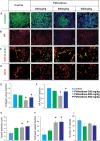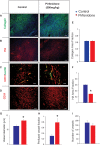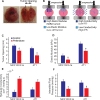Pirfenidone normalizes the tumor microenvironment to improve chemotherapy
- PMID: 28445938
- PMCID: PMC5421866
- DOI: 10.18632/oncotarget.15534
Pirfenidone normalizes the tumor microenvironment to improve chemotherapy
Abstract
Normalization of the tumor microenvironment by selectively targeting components of the tumor extracellular matrix has been recently proposed to have the potential to decompress tumor blood vessels, increase vessel perfusion and thus, improve drug delivery and the efficacy of cancer therapy. Therefore, we now need to identify safe and well tolerated pharmaceutical agents that are able to remodel the microenvironment of solid tumors and enhance chemotherapy. In this study, we repurposed Pirfenidone, a clinically approved anti-fibrotic drug for the treatment of idiopathic pulmonary fibrosis, to investigate its possible role on tumor microenvironment normalization. Using two orthotopic mammary tumor models we demonstrate that Pirfenidone reduces collagen and hyaluronan levels and, as a result, significantly increases blood vessel functionality and perfusion and improves the anti-tumor efficacy of doxorubicin. Reduction of extracellular matrix components were mediated via TGFβ signaling pathway inhibition due to downregulation of TGFβ1, COL1A1, COL3A1, HAS2, HAS3 expression levels. Our findings provide evidence that repurposing Pirfenidone could be used as a promising strategy to enhance drug delivery to solid tumors by normalizing the tumor microenvironment.
Keywords: biomechanics; breast cancer; drug delivery; tumor perfusion; vessel compression.
Conflict of interest statement
None
Figures






Similar articles
-
Tranilast-induced stress alleviation in solid tumors improves the efficacy of chemo- and nanotherapeutics in a size-independent manner.Sci Rep. 2017 Apr 10;7:46140. doi: 10.1038/srep46140. Sci Rep. 2017. PMID: 28393881 Free PMC article.
-
Pirfenidone decreases mesothelioma cell proliferation and migration via inhibition of ERK and AKT and regulates mesothelioma tumor microenvironment in vivo.Sci Rep. 2018 Jul 3;8(1):10070. doi: 10.1038/s41598-018-28297-x. Sci Rep. 2018. PMID: 29968778 Free PMC article.
-
Sonic-hedgehog pathway inhibition normalizes desmoplastic tumor microenvironment to improve chemo- and nanotherapy.J Control Release. 2017 Sep 10;261:105-112. doi: 10.1016/j.jconrel.2017.06.022. Epub 2017 Jun 27. J Control Release. 2017. PMID: 28662901 Free PMC article.
-
Improving drug delivery to solid tumors: priming the tumor microenvironment.J Control Release. 2015 Mar 10;201:78-89. doi: 10.1016/j.jconrel.2014.12.018. Epub 2014 Dec 17. J Control Release. 2015. PMID: 25526702 Review.
-
Pirfenidone for the treatment of idiopathic pulmonary fibrosis.Expert Rev Respir Med. 2014 Oct;8(5):539-45. doi: 10.1586/17476348.2014.915750. Epub 2014 Aug 12. Expert Rev Respir Med. 2014. PMID: 25113033 Review.
Cited by
-
Targeting the Stromal Pro-Tumoral Hyaluronan-CD44 Pathway in Pancreatic Cancer.Int J Mol Sci. 2021 Apr 12;22(8):3953. doi: 10.3390/ijms22083953. Int J Mol Sci. 2021. PMID: 33921242 Free PMC article.
-
Female reproductive life span is extended by targeted removal of fibrotic collagen from the mouse ovary.Sci Adv. 2022 Jun 17;8(24):eabn4564. doi: 10.1126/sciadv.abn4564. Epub 2022 Jun 17. Sci Adv. 2022. PMID: 35714185 Free PMC article.
-
Amniotic epithelial cells reverse abnormal vascular structure and function in endometrial carcinoma.Int J Clin Exp Pathol. 2019 Jul 1;12(7):2405-2424. eCollection 2019. Int J Clin Exp Pathol. 2019. PMID: 31934068 Free PMC article.
-
Combining microenvironment normalization strategies to improve cancer immunotherapy.Proc Natl Acad Sci U S A. 2020 Feb 18;117(7):3728-3737. doi: 10.1073/pnas.1919764117. Epub 2020 Feb 3. Proc Natl Acad Sci U S A. 2020. PMID: 32015113 Free PMC article.
-
Tumor-stromal ratio (TSR) of invasive breast cancer: correlation with multi-parametric breast MRI findings.Br J Radiol. 2019 May;92(1097):20181032. doi: 10.1259/bjr.20181032. Epub 2019 Mar 15. Br J Radiol. 2019. PMID: 30835501 Free PMC article.
References
-
- Chauhan VP, Stylianopoulos T, Boucher Y, Jain RK. Delivery of molecular and nanomedicine to tumors: Transport barriers and strategies. Annu Rev Chem Biomol Eng. 2011;2:281–298. - PubMed
-
- Chauhan VP, Martin JD, Liu H, Lacorre DA, Jain SR, Kozin SV, Stylianopoulos T, Mousa A, Han X, Adstamongkonkul P, Popovic Z, Bawendi MG, Boucher Y, et al. Angiotensin inhibition enhances drug delivery and potentiates chemotherapy by decompressing tumor blood vessels. Nat Commun. 2013;4:2516. doi: 10.1038/ncomms.3516. - DOI - PMC - PubMed
MeSH terms
Substances
LinkOut - more resources
Full Text Sources
Other Literature Sources
Miscellaneous

